
The Cathedral Church of Saint Andrew, also commonly known as St. Andrew's Cathedral, is a cathedral of the Episcopal Church in the United States located in the State of Hawaii. Originally the seat of the Anglican Church of Hawaii, it is now the home of the bishop of the Episcopal Diocese of Hawaii. It is affiliated with St. Andrew's Schools, which consists of the main girls' K-12 school, the coeducational Queen Emma Preschool and a boys' preparatory school (elementary).
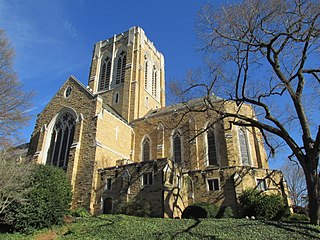
The Cathedral of Saint Philip, also known as St. Philip's Cathedral or St. Philip's is an Episcopal cathedral in the U.S. State of Georgia, in the City of Atlanta. Located on Peachtree Road in Buckhead (Atlanta) at what is popularly called "Jesus Junction". St. Philip's has become one of the largest Episcopal congregations in the United States, with a membership of approximately 7,000. St. Philip's is named in honor of St. Philip the Evangelist, a deacon in the early Christian Church. The Cathedral of St. Philip is the seat of the Episcopal Diocese of Atlanta.
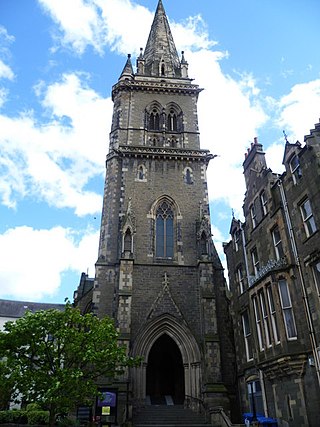
St. Paul's Cathedral is an Anglican cathedral in the city of Dundee, Scotland. It is the cathedral and administrative centre of the Diocese of Brechin in the Scottish Episcopal Church.

The Episcopal Diocese of Atlanta is the diocese of the Episcopal Church in the United States of America, with jurisdiction over middle and north Georgia. It is in Province IV of the Episcopal Church and its cathedral, the Cathedral of St. Philip, is in Atlanta, as are the diocesan offices.

The Episcopal Diocese of Georgia, USA is one of 20 dioceses that comprise Province IV of the US Episcopal Church, and is a diocese within the worldwide Anglican Communion. The current bishop is Frank S. Logue, who succeeded Scott Anson Benhase on May 30, 2020 when he was consecrated 11th Bishop of Georgia at a service held in Christ Church in Savannah, Georgia.
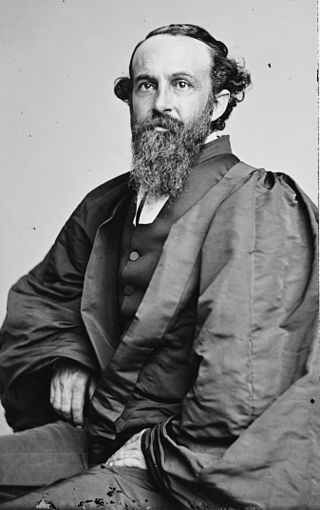
Charles Todd Quintard was an American physician and clergyman who became the second bishop of the Episcopal Diocese of Tennessee and the first Vice-Chancellor of the University of the South.
Religion in Atlanta, while historically centered on Protestant Christianity, now involves many faiths as a result of the city and metro area's increasingly international population. While Protestant Christianity still maintains a strong presence in the city, in recent decades Catholic Christians have gained a strong foothold due to migration patterns. Atlanta also has a considerable number of ethnic Christian congregations, such as Korean Baptist, Methodist, and Presbyterian Churches, the Tamil Church Atlanta, Telugu Church, Hindi Church, Malayalam Church, Ethiopian, Chinese, and many more traditional ethnic religious groups. Large non-Christian faiths are present in the form of Buddhism, Judaism and Hinduism. Overall, there are over 1,000 places of worship within Atlanta.

The Basilica of the Sacred Heart of Jesus is a Roman Catholic church located at 353 Peachtree Street NE in downtown Atlanta, Georgia, United States. The current building was completed in 1898. It was added to the National Register of Historic Places in 1976 and was designated a minor basilica in 2010.
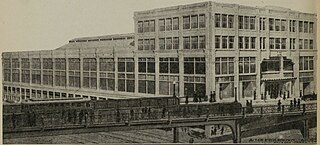
The Peachtree Arcade was a shopping arcade in downtown Atlanta, Georgia, United States. The building, modeled after the Arcade in Cleveland, was designed by Atlanta-based architect A. Ten Eyck Brown and was located between Peachtree Street and Broad Street near Five Points. Construction began in 1917 and was completed the following year. Located in the city's central business district, it was very popular with citizens, functioning as an unofficial "civic center" for the city. However, by the 1960s, the arcade was facing increased competition from shopping malls located in Atlanta's suburbs, and in 1964, the building was demolished to make way for the First National Bank Building, a skyscraper that, at the time of its construction, was the tallest building in both Atlanta and the southeastern United States. In 1993, the American Institute of Architects named the building as one of Atlanta's most notable landmarks to have been destroyed.

The William–Oliver Building is a 1930 Art Deco landmark building at 32 Peachtree Street NW at Five Points, Downtown Atlanta. It currently consists of 115 apartments. Its architect was Francis Palmer Smith of Pringle and Smith and was Atlanta's first completed Art Deco skyscraper. It was named after developer Thomas G. Healey's grandsons William and Oliver.

Trinity Episcopal Cathedral is an historic church building at 310 West 17th Street in Little Rock, Arkansas, United States. It is the seat of the Diocese of Arkansas and is listed on the National Register of Historic Places.
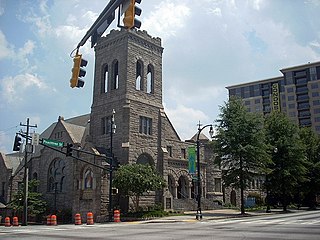
North Avenue Presbyterian Church is a historic Presbyterian church at 607 Peachtree Avenue, NE in Atlanta, Georgia. The church building was completed in 1900 and was added to the National Register of Historic Places in 1978.

The Lutheran Church of the Redeemer is a Lutheran church in midtown Atlanta, Georgia. The congregation was founded in the city in 1903, with the current building constructed in 1952.

200 Peachtree is a mixed-use retail center in downtown Atlanta, Georgia designed by Philip T. Shutze and Starrett & van Vleck. Built in 1927 as the flagship department store for Davison's, the last department store in the building closed in 2003. The building later underwent an extensive renovation in the 2010s.
Jasper Newton "Jack" Smith was an American businessman from Georgia. Born in Walton County, he moved to Atlanta following the Civil War where he became a successful and eccentric businessman.

Founded in the 1830s as a railroad terminus, Atlanta experienced rapid growth in its early years to become a major economic center of Georgia, with several hotels built to accommodate for this growth. Following its destruction during the Civil War, Atlanta experienced a resurgence and another hotel boom commenced in the late 1800s through the early 1900s. In the later half of the 20th century, hotel skyscrapers began to appear on the skyline, including what was at the time the tallest hotel in the United States. Later, a trend emerged of converting old office buildings into boutique hotels.

All Saints' Episcopal Church is an Episcopal church in Atlanta, Georgia. The church was founded in 1903, with the current building constructed in 1906.

Christ Church is an Episcopal church at 28 Bull Street, Johnson Square, in Savannah, Georgia. Founded in 1733, it was the first church established in the Province of Georgia and one of the first parishes within the Episcopal Diocese of Georgia, earning it the nickname "the Mother Church of Georgia". The present church building was constructed in 1838 and is located in the Savannah Historic District.

Grace United Methodist Church is a Methodist church in Atlanta, Georgia, United States. Originally organized as a mission in 1871, the current church building was designed by Francis Palmer Smith and was completed in 1923.

Pershing Point Park, also known as Pershing Point Memorial Park, is a small public park in Atlanta, Georgia, United States. The park, located in midtown Atlanta, is formed by the intersection of Peachtree Street and West Peachtree Street. It was dedicated in the 1920s in honor of General of the Armies John J. Pershing and includes a memorial to Fulton County soldiers who died in World War I. The World Athletes Monument is also located in the park. A 2018 article in The Atlanta Journal-Constitution listed the park as one of three World War I memorials in the Atlanta metropolitan area.





















